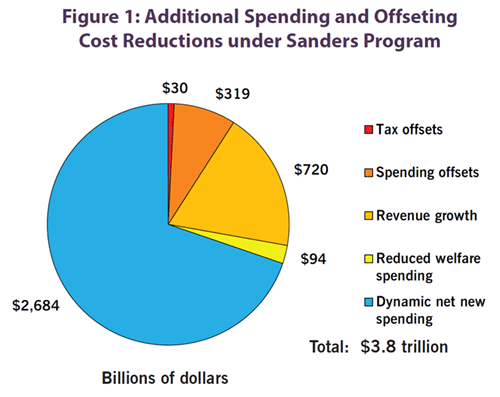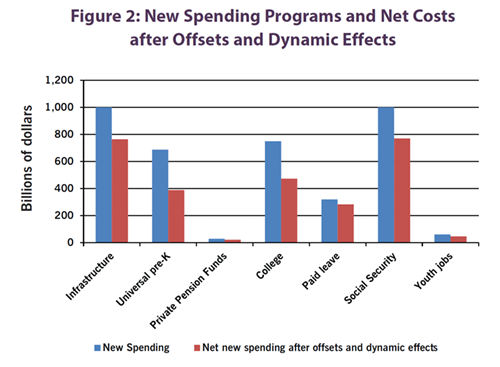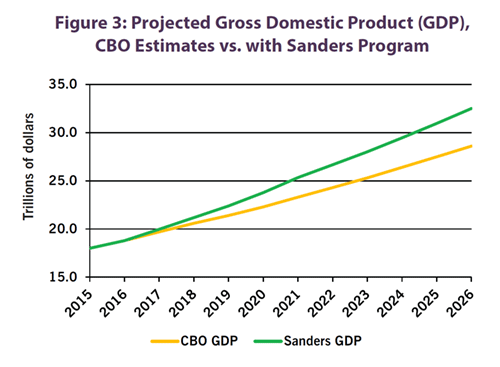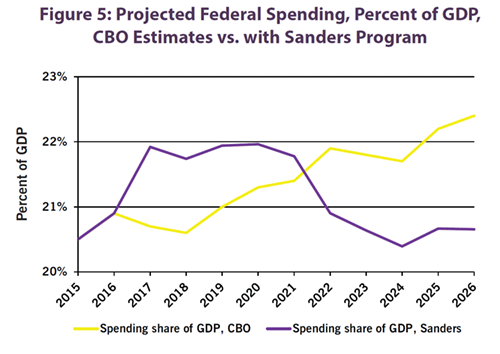No one should be surprised by the popular support that Sen. Bernie Sanders (I-Vt.) has attracted in his run for president as a democratic socialist. Nor should we be surprised that he has drawn attacks charging that his policies will bankrupt the United States. Sanders' proposals for infrastructure, early-childhood education, higher education, youth employment, family leave, private pensions, and Social Security would total over $3.8 trillion over 10 years. While this is a large number, it would be barely 6% of federal spending for 2017-2026.
Apart from any benefits these programs would bring directly, their cost would be reduced in four ways: Two operate by offsetting current spending and tax policies--either replacing existing federal spending or reducing tax breaks currently subsidizing private spending. The other two, which account for over 70% of the cost reduction, are the "dynamic effects" of increased economic growth--boosting tax revenues and reducing federal safety-net spending when the economy expands.
A quarter of new spending would be offset by savings and by faster economic growth. (See Figure 1.) The ongoing effects of the Great Recession that began in 2007 have left many resources underutilized. By putting unemployed workers and discouraged workers (who have stopped looking for jobs) back to work, the Sanders program would increase economic activity and government revenues while reducing spending on safety-net programs like Supplemental Nutrition.
Taking these dynamic effects into account, the net cost to the public treasury would be about $2.7 trillion, instead of $3.8 trillion, over 10 years. That is, over a quarter of the total tab would be offset by reductions in other forms of government spending and by increased tax revenue derived from faster economic growth.

Each of the seven spending proposals would benefit from offsets and dynamic effects. (See Figure 2.) Universal childcare and free college tuition, for example, would replace existing spending on programs for childcare assistance and much of the spending on Pell Grants for students at public colleges, spending on infrastructure would offset some required maintenance spending, and raising Social Security benefits would allow some seniors to avoid dependence on Supplemental Nutrition (SNAP) and other safety net programs. The programs would also increase tax revenues by eliminating some existing "tax expenditures"--tax breaks that subsidize private spending--like deductions for employer-provided child care.

The programs would accelerate the recovery from the Great Recession. (See Figure 3.) Eight years after the beginning of the Great Recession, the American economy remains depressed. While the economy has been growing steadily since the end of 2009, output remains nearly 5% below capacity. Only 59% of the adult population is employed, down from over 63% before the recession and the lowest level in 30 years.
I estimate that, due to increased government spending, the Sanders program would increase GDP growth rates for 2017-2026 enough to result in a projected GDP in 2026 $4 trillion higher than without the programs.

The Sanders program would add six million new jobs. (See Figure 4.) The Congressional Budget Office (CBO) projects that, due to sluggish economic growth, the percentage of the working-age population employed will fall between now and 2026, from 59% to 57%. The Sanders program would directly create jobs in infrastructure, in child-care services, in higher education, and for young people. It would also create additional jobs indirectly, as the newly employed and others spend their additional income. All told, I calculate that the program would raise employment by six million jobs by 2026.

Government spending would decline relative to GDP within the decade. (See Figure 5.) Federal spending would initially increase faster than GDP under the Sanders program. After 2021, however, federal spending would be lower as a percentage of GDP than it would be under Congressional Budget Office (CBO) projections, because of the strength of the economic recovery engendered by the Sanders stimulus. This is actually a conservative estimate of the boost to GDP because it does not include the productivity-raising effects of infrastructure spending and increased education.

Laurence M. Ball, Daniel Leigh, and Prakash Loungani, Okun’s Law: Fit at Fifty?, Working Paper, National Bureau of Economic Research, January 2013;
Congressional Budget Office, Estimated Impact of the American Recovery and Reinvestment Act on Employment and Economic Output from October 2012 Through December 2012, Congressional Budget Office, February 2013;
Congressional Budget Office, How CBO Analyzes the Effects of Changes in Federal Fiscal Policies on the Economy, Congressional Budget Office, November 2014;
Friedman Analysis of HR 676: Medicare for All Would Save Billions, Official Blog of Physicians for a National Health Plan, Accessed January 24, 2014;
Gerald Friedman, An Open Letter to the Wall Street Journal on Its Bernie Sanders Hit Piece, The Huffington Post, Accessed October 3, 2015;
Gerald Friedman, Universal Health Care: Can We Afford Anything Less?, Dollars & Sense, July/August 2011; Keith Hall, How CBO Will Implement Dynamic Scoring: Presentation at the Heritage Foundation, Heritage Foundation/ Congressional Budget Office, June 17, 2015;
Laura Meckler, Price Tag of Bernie Sanders’s Proposals: $18 Trillion, Wall Street Journal, September 14, 2015;
The 2015 Long-Term Budget Outlook, Congressional Budget Office, Accessed September 21, 2015.
